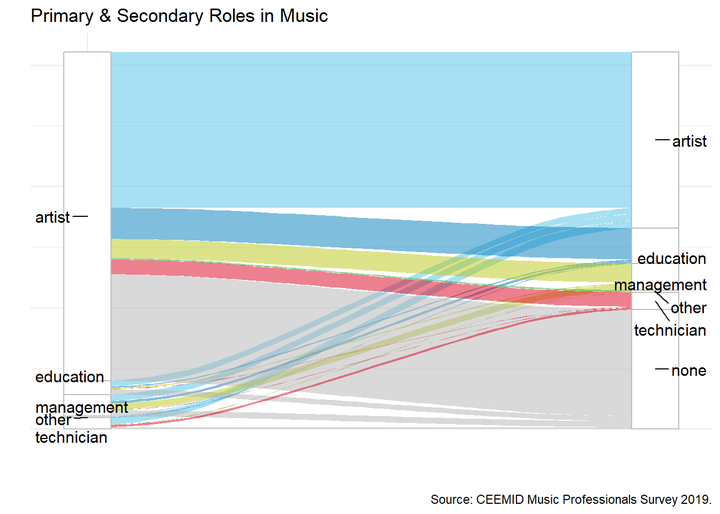An Empirical Approach To Modernizing The Cultural and Creative Occupations and Skills Classifications
 Grouping of economic activities and jobs in typical music occupations
Grouping of economic activities and jobs in typical music occupationsCEEMID has been conducting surveys among music and film professionals for 6 years. So far, about 5000 music and 1500 film professionals filled out our detailed questionnaire about their working conditions, skills, tasks. Some of our surveys were related to training needs assessments, and other professional growth assessments.
The ESCO system builds on occupations, skills and qualifications. Our general experience is that in the music and film industry, because of the lack of life-long learning opportunities, the absence of large employers, low level of unionization, and generally the mixed nature of occupations, informal learning practices play a very important role. Therefore, the skills and especially the qualifications pillars of the ESCO system are less helpful in their current forms.
A very important problem with the occupations pillar is that creative workers tend to work in microenterprises without a high degree of specialization, and they tend to mix artistic professional, technician and other occupational tasks. Obviously, in these microenterprises, where there are no HR professional present, we cannot talk about job descriptions, and we devised an empirical strategy to evaluate the actual occupation of our respondents. We created industry-specific taxonomies of economic activities that we tried to map with economic activities (which came more natural in microenterprises than job descriptions), education, and occupational groups. In our surveys, we asked music and film professionals to self-identify with a primary, and an optional secondary 100 music industry specific and about 250 film industry specific role.
The creation of a recorded music product or a live music performance typically requires the contribution of 9-250 professionals, while a film may require 30-3000 people to produce, including almost all elements of the music output. Unsurprisingly, we found a higher level of specialization in the film industry than in the music industry, but in both industries, it was common that a creative worker’s occupation could be mapped to both an artistic professional and a technician role. The role of qualifications played a very little role, particularly in the popular music field, where most roles are anyway learned in informal learning practices. Because most creative workers work in some entrepreneurial form, we used both ESCO and NACE coding to identify their main tasks. As a starting point, we used the 5-digit national NACE economic activity descriptions of Hungary, and adjusted them in consultation with key professionals, film producers as employers and professional associations.
We have a large enough answer pool — sometimes proven to be representative of the country’s professional group population — that we would be able to create new occupational descriptions on an empirical basis. We are able to perform clustering of job descriptions, earnings, educational levels, and work output (such as films, documentaries, TV programmes, live music performances, music compositions, etc) to empirically create groups with a “set of jobs whose main tasks and duties are characterised by a high degree of similarity” in terms of economic activity and work output.
It is a well-known fact that creative economic activities require complex mapping because freelancer, micro- and small enterprises are mixing heterogenous activities that are stretching across various economic activity (NACE) classes and ESCO occupational groups.

Empirically, we see that creative people are usually combining various artistic roles.(The chart above is taken from the 3.2 chapter of the Central European Music Industry Report)
The combination of technical and artistic roles is also very frequent, and a sizeable minority combines artistic and educational, artistic and managerial or artistic and technical roles. The ‘occupation’ chosen for the workshop, i.e. ‘singer’, is a rather rare one, as the most likely artistic occupation in popular music is ‘singer-songwriter’. Singers can be found often to work in sound engineering, too. Generally, up to half of the roles that creatives are performing are combining 264-265 artistic Professional elements and the very broad 3435 Other artistic and cultural associate professionals’ roles. Furthermore, in both the music and the film industry, the general educational level can be quiet low — both industries create a lot of jobs for young, not highly-educated people —, where clerical support work elements, or elementary professions elements are mixing with either technician or artistic roles.
Our research was not designed to identify new ESCO groups, but we believe that our data is very well suited for this. Interestingly, much of our research arrived at occupational groupings from a learning needs assessment or educational needs assessment perspective, which we believe to be very problematic in both the music and film industry. Almost all creative industry professionals in the music and film industry work in microenterprises, a small minority in small enterprises, and only a very few people in medium-sized enterprises. Micro-enterprises and small enterprises usually have no strategic HR functions, do not perform learning needs, do not offer in-house training, and do not have the ability to send workers to any regular formal training. This leads to a very wasteful human resources management, because there is a huge workforce surplus present, but at the same time, because of skills shortages, key workers are extremely overworked, and generally there is a huge structural workforce shortage present.
Further reading: